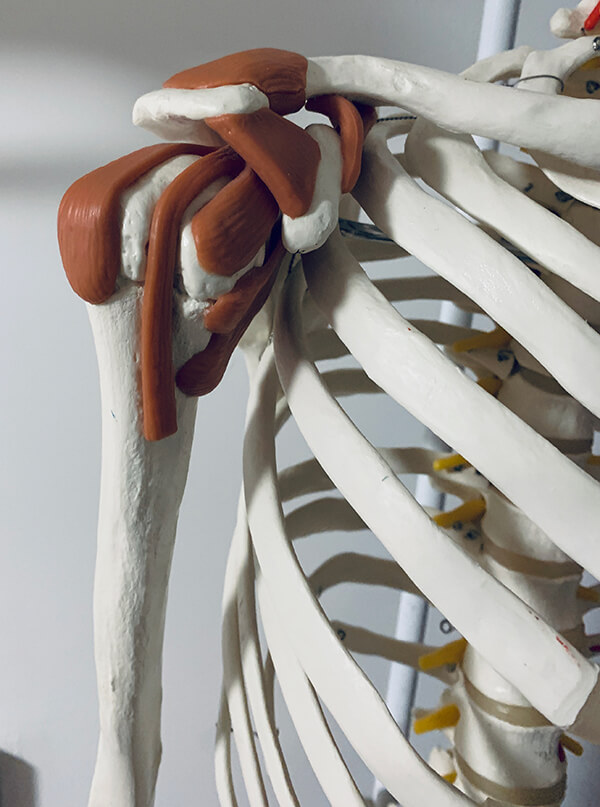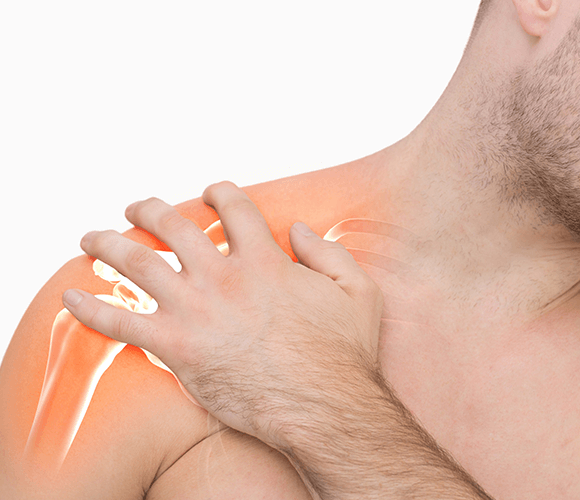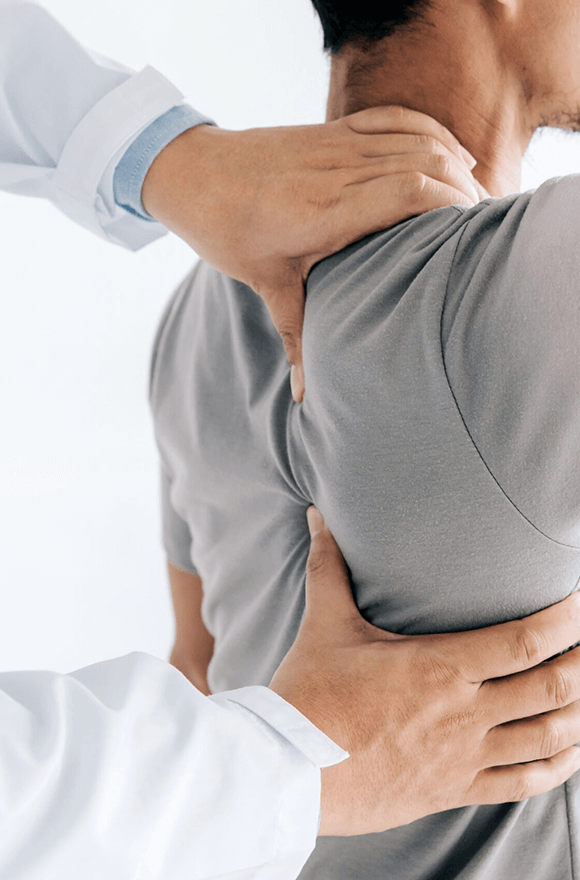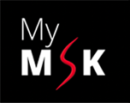Rotator Cuff Injury
What is the Rotator Cuff?
The Rotator Cuff is a group of four muscles which help stabilise and at the same time mobilise the shoulder joint, the most mobile joint in the body.
These four muscles are the supraspinatus, subscapularis, infraspinatus and teres minor.
The most common injured muscle in this group is the Supraspinatus muscle (responsible for initiating the lifting of the shoulder in a sideways arc direction)
This muscle is responsible for helping lift the arm from the side before the deltoid takes over as we continue to raise the arm.
This muscle can have a small tear from lifting or a sudden pull which is termed ‘a partial thickness’ tear.
Another cause of injury we often see in this muscle may be due to ‘shoulder impingement syndrome’ where chronic ‘rubbing’ of this muscle against the underside of the acromion (outer bone) next to the clavicle may cause tendinitis, tendinopathy, calcification, degeneration and eventually a tear. Think of the analogy of a rope scraping against a rock where the fibres slowly wear away over time.


What causes Shoulder impingement?
Often a rounded posture with rounded shoulders causes a forward rotation of the scapula. This can cause the biomechanics of shoulder movement to be altered in such a way that the distance between the acromion and supraspinatus or even bursa (fluid filled bursa) above it scrapes against the underside of the acromion or is squeezed against it.
Another reason you may experience shoulder impingement syndrome is weakness of the ‘external rotators’ of the shoulder muscle; Teres Major and the Infraspinatus.
The infraspinatus muscle is a muscle often injured in activities involving overhead throwing e.g cricket or baseball
Rotator Cuff Partial thickness or full thickness tear
With a partial thickness tear you can still lift the shoulder but some discomfort or pain may be felt.
These can often be treated with injections into the tendon with PRP or prolotherapy or a steroid injection into the subacromial bursa allowing the muscle to be strengthened with specific physical therapy exercises
Injury to any of the rotator cuff muscles leads to shoulder pain and weakness in movement. This can happen during movements such as pushing out with the arm, lifting, over arm throwing.

Rotator Cuff Tear or Strain?
Shoulder Rotator Cuff Strain is often a diagnosis given when the shoulder pain and presentation is unclear. This is not always the case of course but often a detailed examination and scan of the shoulder has not been done. Rather an incomplete history and examination has been taken.
With a through examination and usually a scan in addition (Ultrasound scan or MRI) , these tears can be accurately diagnosed as ‘Partial thickness Rotator Cuff tears‘ or ‘Full Thickness Rotator Cuff Tears‘
A Rotator Cuff strain strain really refers to micro-trauma in the muscle fibres which usually heals within 4-6 weeks.
If pain has been there longer than this then imaging is required starting with an X-ray

How do we diagnose Rotator Cuff Injury?
The most common investigation recommended in most shoulder issues is an xray +/- ultrasound scan
Ultrasound scan is ideal for a detailed scan of the Rotator Cuff Muscles because it can analyse them under movement which can identify rotator cuff strains or tears better than an MRI scanner. MRI scan is still a very useful scan for Rotator Cuff Muscle injuries but an Ultrasound is preferable initially because of its lower cost and easier accesibility. MRI is better at picking up other shoulder injuries such as labral tears.
In Rotator Cuff injuries, we often see tears and tendinosis (a process of ‘wear and tear’) in rotator cuff muscles tendons (small rope like slips which attach muscle to bone)
If tendinosis id left untreated, this can lead to a partial thickness or full thickness tears of the tendons
A partial thickness tear often still allows the shoulder to function at a relatively good level of strength. It often has good potential for healing with rehabilitation by an osteopath.
Here at the mymsk clinic we are able to inject the tendon under Ultrasound guidance with Platelet Rich Plasma which can help ‘regenerate’ the muscle if rehab exercises are perfomed with it. This can help the patient avoid surgery
A full width complete thickness rotator cuff tear often prompts referral to an Orthopaedic surgeon.
The patient usually notices a loss of strength and even simple movements of the shoulder are very weak although quite often painless
Your “rotator cuff” is made up of the muscles and tendons that hold your shoulder in place. It is one of the most important parts of your shoulder. Your rotator cuff allows you to lift your arms and reach up. Every year tens of thousands of people suffer pain because of injury to this muscle group.
Rotator cuff injury should always be taken seriously because you cannot simply stop using your shoulder – but if you continue to use a damaged shoulder without seeking treatment you could make the problem worse.
Many people think that surgery is the only effective treatment for the rotator cuff injury caused by inflammation in the muscles that support your shoulders.
Your shoulders can move out of alignment, leading to issues such as inflammation, pain, and muscle spasms. When this happens, the misalignment can be corrected by gentle manipulation and mobilisation to your shoulder performed by your an Osteopath.
In addition exercises to rebalance the rotator cuff muscles and even an injection into the subacromial bursa (small pouch above the rotator cuff) can be given to help heal the Rotator Cuff muscles. Rotator cuff treatment of this nature can help you to avoid the need for surgical intervention.
Prolotherapy treatments
Prolotherapy treatments have also been used for treating patients with rotator cuff tears of the shoulder for many years. The most common form of rotator cuff injury is in the tendons of the shoulder muscles. The most commonly affected muscle is the supraspinatus, which is the smallest of the rotator cuff muscles. A lifetime of wear and tear can cause this hard-working muscle to become torn, which can lead to persistent pain and put extra strain on the other muscles in the rotator cuff. Physical therapy can be very helpful in dealing with such issues.
Your torn rotator cuff treatment may include a range of rotator cuff physio exercises. These are generally gentle, low intensity movements designed to gradually build up strength in the damaged muscles without putting them under undue stress. Physical therapy combined with Prolotherapy or PRP injections can be an effective, non-surgical rotator cuff treatment that will help your shoulder heal and allow you to return to full, pain free movement thanks to rotator cuff physio techniques.
There are several rotator cuff physio exercises that can be useful in returning an injured shoulder to health. The “doorway stretch” involves gripping each side of a doorway at, or just below your shoulder height and leaning forwards through the doorway until you feel a light stretch. Keeping your back straight, slowly shift your weight onto your toes. Again, you will feel a slight stretch in the front of your shoulder. This is an excellent mobility exercise used in our Rotator Cuff exercise rehabilitation program.

One of the main rotator cuff exercise we advocate is the side raise. This consists of the patient holding a very light weight, dumbbell or bottle of water and raising it to the side very slowly. This can be done with one arm or both arms with a pause for a few seconds at the top. This exercise strengthens the supraspinatus muscle
Another very simple rotator cuff physio exercise “side-lying external rotation”. This involves the patient lying on their non-injured side. Bend the arm to a ninety-degree angle with the elbow resting on your side and your forearm resting across your abdomen. Holding a light dumbbell (or can of beans) in the hand on your injured side, slowly and gently raise the dumbbell (or bean can) towards the ceiling, holding it aloft for a few seconds before returning to the start position. This exercise helps strengthen the infraspinatus, a key rotator cuff muscle. Always stop any exercise for torn rotator cuff treatment if you feel strain, and always gently warm your muscles up before engaging in any kind of exercise.
Whether your pain is the result of a sporting injury, over exertion, or simply the wear and tear of an active life, you do not need to live with the discomfort of a torn rotator cuff.
Treatment, using Rotator cuff exercises under the supervision of our highly qualified clinical staff can help you to alleviate discomfort and avoid surgical intervention. So if you have Rotator Cuff Injury – Talk to us to get information on all its symptoms, diagnoses, treatments and rehabilitation exercises.
Treatments

Joint Injections
Combined with rehab program, joint injection treatments at MyMSK Clinic show exciting and promising results
Explore More
Cortisone Injections
A Cortisone Injection (termed steroid injection in the UK) is an anti inflammatory injection for the joints or body tissue to relieve pain.
Explore More
Platelet Rich Plasma
PRP treatment can reduce the need for anti-inflammatory medication or strong painkillers with unwanted side effects
Explore More
Prolotherapy
A regenerative treatment for chronic painful joints and ligaments which involves the injection of a specially formulated solution into damaged tissue.
Explore MoreFor an Assessment of Rotator Cuff Injury
Contact us
We’d love to hear from you!
Just reach out and contact us via any of
these channels:

Call us on

Email us on

Call us on





